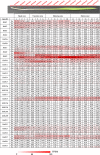Genome-wide systematic characterization of the HAK/KUP/KT gene family and its expression profile during plant growth and in response to low-K+ stress in Saccharum
- PMID: 31931714
- PMCID: PMC6958797
- DOI: 10.1186/s12870-019-2227-7
Genome-wide systematic characterization of the HAK/KUP/KT gene family and its expression profile during plant growth and in response to low-K+ stress in Saccharum
Abstract
Background: Plant genomes contain a large number of HAK/KUP/KT transporters, which play important roles in potassium uptake and translocation, osmotic potential regulation, salt tolerance, root morphogenesis and plant development. Potassium deficiency in the soil of a sugarcane planting area is serious. However, the HAK/KUP/KT gene family remains to be characterized in sugarcane (Saccharum).
Results: In this study, 30 HAK/KUP/KT genes were identified in Saccharum spontaneum. Phylogenetics, duplication events, gene structures and expression patterns were analyzed. Phylogenetic analysis of the HAK/KUP/KT genes from 15 representative plants showed that this gene family is divided into four groups (clades I-IV). Both ancient whole-genome duplication (WGD) and recent gene duplication contributed to the expansion of the HAK/KUP/KT gene family. Nonsynonymous to synonymous substitution ratio (Ka/Ks) analysis showed that purifying selection was the main force driving the evolution of HAK/KUP/KT genes. The divergence time of the HAK/KUP/KT gene family was estimated to range from 134.8 to 233.7 Mya based on Ks analysis, suggesting that it is an ancient gene family in plants. Gene structure analysis showed that the HAK/KUP/KT genes were accompanied by intron gain/loss in the process of evolution. RNA-seq data analysis demonstrated that the HAK/KUP/KT genes from clades II and III were mainly constitutively expressed in various tissues, while most genes from clades I and IV had no or very low expression in the tested tissues at different developmental stages. The expression of SsHAK1 and SsHAK21 was upregulated in response to low-K+ stress. Yeast functional complementation analysis revealed that SsHAK1 and SsHAK21 could rescue K+ uptake in a yeast mutant.
Conclusions: This study provided insights into the evolutionary history of HAK/KUP/KT genes. HAK7/9/18 were mainly expressed in the upper photosynthetic zone and mature zone of the stem. HAK7/9/18/25 were regulated by sunlight. SsHAK1 and SsHAK21 played important roles in mediating potassium acquisition under limited K+ supply. Our results provide valuable information and key candidate genes for further studies on the function of HAK/KUP/KT genes in Saccharum.
Keywords: Evolution; Gene expression; HAK/KUP/KT; Low-K+ stress; Saccharum.
Conflict of interest statement
The authors declare that they have no competing interests.
Figures









Similar articles
-
Genome-wide survey of KT/HAK/KUP genes in the genus Citrullus and analysis of their involvement in K+-deficiency and drought stress responses in between C. lanatus and C. amarus.BMC Genomics. 2024 Sep 5;25(1):836. doi: 10.1186/s12864-024-10712-5. BMC Genomics. 2024. PMID: 39237905 Free PMC article.
-
Genome-Wide Identification and Analysis of HAK/KUP/KT Potassium Transporters Gene Family in Wheat (Triticum aestivum L.).Int J Mol Sci. 2018 Dec 10;19(12):3969. doi: 10.3390/ijms19123969. Int J Mol Sci. 2018. PMID: 30544665 Free PMC article.
-
Genome-Wide Survey and Expression Analysis of the KT/HAK/KUP Family in Brassica napus and Its Potential Roles in the Response to K+ Deficiency.Int J Mol Sci. 2020 Dec 13;21(24):9487. doi: 10.3390/ijms21249487. Int J Mol Sci. 2020. PMID: 33322211 Free PMC article.
-
Plant HAK/KUP/KT K+ transporters: Function and regulation.Semin Cell Dev Biol. 2018 Feb;74:133-141. doi: 10.1016/j.semcdb.2017.07.009. Epub 2017 Jul 13. Semin Cell Dev Biol. 2018. PMID: 28711523 Review.
-
Plant KT/KUP/HAK potassium transporters: single family - multiple functions.Ann Bot. 2007 Jun;99(6):1035-41. doi: 10.1093/aob/mcm066. Epub 2007 May 11. Ann Bot. 2007. PMID: 17495982 Free PMC article. Review.
Cited by
-
Gb_ANR-47 Enhances the Resistance of Gossypium barbadense to Fusarium oxysporum f. sp. vasinfectum (FOV) by Regulating the Content of Proanthocyanidins.Plants (Basel). 2022 Jul 22;11(15):1902. doi: 10.3390/plants11151902. Plants (Basel). 2022. PMID: 35893607 Free PMC article.
-
Genome-wide identification, characterization and expression pattern analysis of HAK/KUP/KT potassium transporter gene family in potato.Front Plant Sci. 2025 Jan 16;15:1487794. doi: 10.3389/fpls.2024.1487794. eCollection 2024. Front Plant Sci. 2025. PMID: 39886687 Free PMC article.
-
Transcriptome-wide identification and expression analysis of the KT/HAK/KUP family in Salicornia europaea L. under varied NaCl and KCl treatments.PeerJ. 2022 Mar 3;10:e12989. doi: 10.7717/peerj.12989. eCollection 2022. PeerJ. 2022. PMID: 35261820 Free PMC article.
-
Integrated Analysis of miRNAs Associated With Sugarcane Responses to Low-Potassium Stress.Front Plant Sci. 2022 Jan 4;12:750805. doi: 10.3389/fpls.2021.750805. eCollection 2021. Front Plant Sci. 2022. PMID: 35058942 Free PMC article.
-
Genome-wide characterization and expression analysis of HAK K+ transport family in Ipomoea.3 Biotech. 2021 Jan;11(1):3. doi: 10.1007/s13205-020-02552-3. Epub 2020 Nov 27. 3 Biotech. 2021. PMID: 33269187 Free PMC article.
References
-
- Leigh RA, Wyn Jones RG. A hypothesis relating critical potassium concentrations for growth to the distribution and function of this ion in the plant cell. New Phytol. 1984;97:1–13. doi: 10.1111/j.1469-8137.1984.tb04103.x. - DOI
-
- Coale FJ, Izuno FT, Bottcher AB. Nutrient accumulation and removal by sugarcane grown on Everglades Histosols. Agron J. 1993;85:310–315. doi: 10.2134/agronj1993.00021962008500020028x. - DOI
-
- Wood RA. The roles of nitrogen, phosphorus and potassium in the production of sugarcane in South Africa. Fertilizer Res. 1990;26:89–98. doi: 10.1007/BF01048746. - DOI
-
- White PJ. Improving potassium acquisition and utilisation by crop plants. J Plant Nutr Soil Sci. 2013;176(3):305–316. doi: 10.1002/jpln.201200121. - DOI
MeSH terms
Substances
Grants and funding
- 2019GDASYL-0103028/GDAS' Project of Science and Technology Development
- 2019GDASYL-0104013 and 2017GDASCX-0105/the special funds of the Guangdong Academy of Science
- 2019KJ104-04/Guangdong Provincial Team of Technical System Innovation for Sugarcane Sisal Hemp Industry
- 2014B070705002/the Science and Technology Planting Project of Guangdong Province
- CARS201707/China Agricultural Research System
LinkOut - more resources
Full Text Sources
Medical

